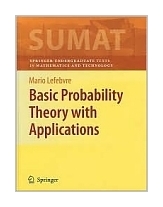This book presents elementary probability theory with interesting and
well-chosen applications that illustrate the theory.
An introductory chapter reviews the basic elements of differential calculus
which are used in the material to follow. The theory is presented systematically,
beginning with the main results in elementary probability theory. This is followed by
material on random variables. Random vectors, including the all important central limit
theorem, are treated next. The last three chapters concentrate on applications of this
theory in the areas of reliability theory, basic queuing models, and time series. Examples
are elegantly woven into the text and over 400 exercises reinforce the material and
provide students with ample practice.
This textbook can be used by undergraduate students in pure and applied sciences such
as mathematics, engineering, computer science, finance and economics.
A separate solutions manual is available to instructors who adopt the text for their
course.
Table of Contents
1 Review of differential calculus
1.1 Limits and continuity
1.2 Derivatives
1.3 Integrals
1.3.1 Particular integration techniques
1.3.2 Double integrals
1.4 Infinite series
1.4.1 Geometric series
1.5 Exercises for Chapter 1
2 Elementary probability
2.1 Random experiments
2.2 Events
2.3 Probability
2.4 Conditional probability
2.5 Total probability
2.6 Combinatorial analysis
2.7 Exercises for Chapter 2 .
3 Random variables
3.1 Introduction
3.1.1 Discrete case
3.1.2 Continuous case
3.2 Important discrete random variables
3.2.1 Binomial distribution
3.2.2 Geometric and negative binomial distributions
3.2.3 Hypergeometric distribution
3.2.4 Poisson distribution and process
3.3 Important continuous random variables
3.3.1 Normal distribution
3.3.2 Gamma distribution
3.3.3 Weibull distribution
3.3.4 Beta distribution
3.3.5 Lognormal distribution
3.4 Functions of random variables
3.4.1 Discrete case
3.4.2 Continuous case
3.5 Characteristics of random variables
3.6 Exercises for Chapter 3
4 Random vectors .
4.1 Discrete random vectors .
4.2 Continuous random vectors
4.3 Functions of random vectors
4.3.1 Discrete case
4.3.2 Continuous case
4.3.3 Convolutions
4.4 Covariance and correlation coefficient .
4.5 Limit theorems .
4.6 Exercises for Chapter 4 .
5 Reliability
5.1 Basic notions
5.2 Reliability of systems
5.2.1 Systems in series
5.2.2 Systems in parallel
5.2.3 Other cases
5.3 Paths and cuts
5.4 Exercises for Chapter 5
6 Queueing
6.1 Continuous-time Markov chains
6.2 Queueing systems with a single server
6.2.1 The M/M/1 model
6.2.2 The M/M/1 model with finite capacity .
6.3 Queueing systems with two or more servers
6.3.1 The M/M/s model
6.3.2 The M/M/s/c model
6.4 Exercises for Chapter 6
7 Time series .
7.1 Introduction
7.2 Particular time series models
7.2.1 Autoregressive processes
7.2.2 Moving average processes
7.2.3 Autoregressive moving average processes
7.3 Modeling and forecasting
7.4 Exercises for Chapter 7
A List of symbols and abbreviations .
B Statistical tables
C Solutions to “Solved exercises”
D Answers to even-numbered exercises
E Answers to multiple choice questions .
References
Index
340 pages, Hardcover
Księgarnia nie działa. Nie odpowiadamy na pytania i nie realizujemy zamówien. Do odwolania !.


